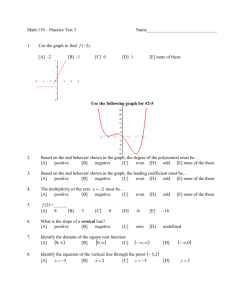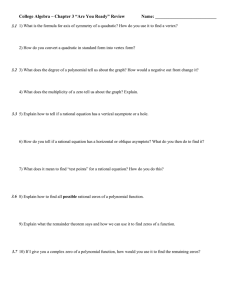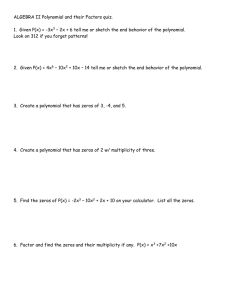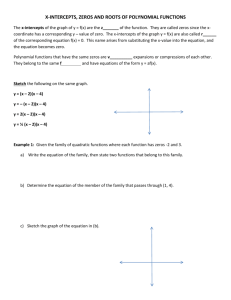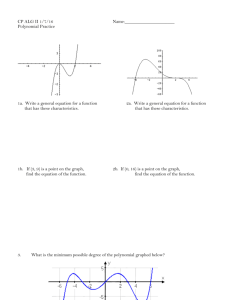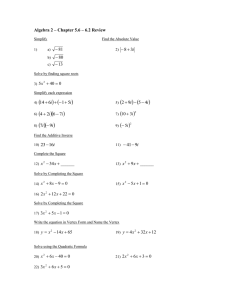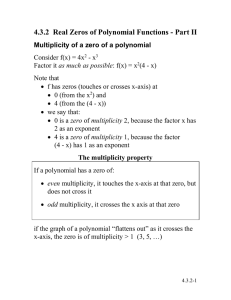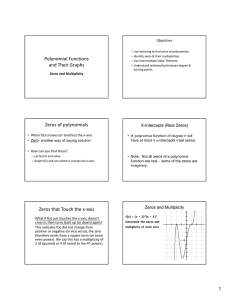Exam_3_Review hcc.doc
advertisement
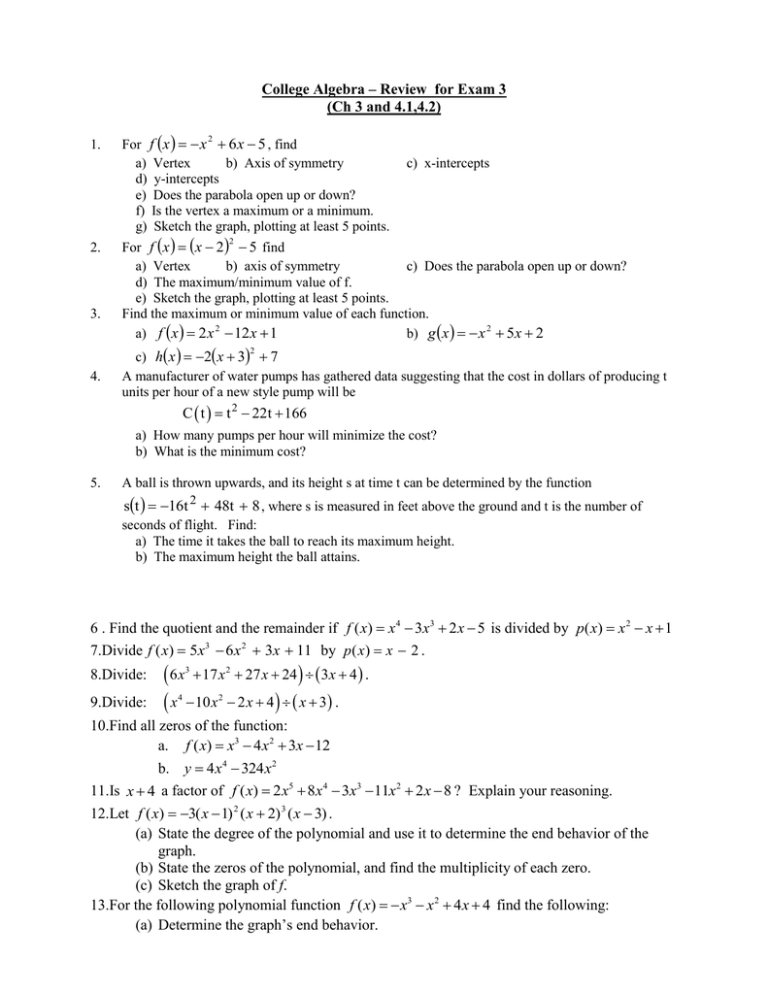
College Algebra – Review for Exam 3 (Ch 3 and 4.1,4.2) 1. 2. 3. For f x x 2 6 x 5 , find a) Vertex b) Axis of symmetry d) y-intercepts e) Does the parabola open up or down? f) Is the vertex a maximum or a minimum. g) Sketch the graph, plotting at least 5 points. c) x-intercepts For f x x 2 5 find a) Vertex b) axis of symmetry c) Does the parabola open up or down? d) The maximum/minimum value of f. e) Sketch the graph, plotting at least 5 points. Find the maximum or minimum value of each function. a) f x 2 x 2 12 x 1 b) g x x 2 5 x 2 2 c) h x 2 x 3 7 A manufacturer of water pumps has gathered data suggesting that the cost in dollars of producing t units per hour of a new style pump will be 2 4. C t t 2 22t 166 a) How many pumps per hour will minimize the cost? b) What is the minimum cost? 5. A ball is thrown upwards, and its height s at time t can be determined by the function st 16t 2 48t 8 , where s is measured in feet above the ground and t is the number of seconds of flight. Find: a) The time it takes the ball to reach its maximum height. b) The maximum height the ball attains. 6 . Find the quotient and the remainder if f ( x) x 4 3x3 2 x 5 is divided by p( x) x 2 x 1 7.Divide f ( x) 5x3 6 x 2 3x 11 by p ( x) x 2 . 8.Divide: 9.Divide: 6 x 17 x 27 x 24 3x 4 . x 10 x 2 x 4 x 3 . 3 4 2 2 10.Find all zeros of the function: a. f ( x) x3 4 x 2 3x 12 b. y 4 x 4 324 x 2 11.Is x 4 a factor of f ( x) 2 x5 8x 4 3x3 11x 2 2 x 8 ? Explain your reasoning. 12.Let f ( x) 3( x 1) 2 ( x 2) 3 ( x 3) . (a) State the degree of the polynomial and use it to determine the end behavior of the graph. (b) State the zeros of the polynomial, and find the multiplicity of each zero. (c) Sketch the graph of f. 13.For the following polynomial function f ( x) x3 x 2 4 x 4 find the following: (a) Determine the graph’s end behavior. (b) Find the x-intercepts. State whether the graph crosses the x-axis or touches the x-axis and turns around at each intercept. (c) Find the y-intercept. (d) Determine whether the graph has y-axis symmetry, origin symmetry, or neither. (e) Sketch the graph plotting additional points as necessary. 1 14.Find the fourth degree polynomial function with leading coefficient whose graph is 30 shown below: 6 6 -6 -6 15.Find the zeros of each function. (a) f ( x) x 3 4 x 2 x 6 (b) f ( x) 2 x 4 3x3 8 x 2 6 x 9, given that -1 is a zero of this function (c) f ( x) x 4 x3 7 x 2 9 x 18 , given that 2 is a zero of this function. (d) f ( x) x 4 2 x3 8x 2 10 x 15 , given that 1 is a zero of this function. 16.List all the possible rational zeros of the following polynomial functions. (a) f ( x) x3 14 x 2 9 x 12 (b) f ( x) 2 x3 9 x 2 7 x 10 17.State the equation(s) of any horizontal and/or vertical asymptotes of each rational function. 7x x 2 14 x 48 (a) f ( x) 2 (b) y 2 x 9 x 2 x 35 3 x 7 3x 2 1 (c) f ( x) (d) f ( x) 5x 2 x 5 x3 4 x2 (f) y 2 2 x 5x 6 x 2x 18.Graph each of the following rational functions: 2x 1 x2 x 2 (a) f ( x) (b) f ( x) 2 x2 x x6 x 1 (c) f ( x) 2 x x 12 (e) y 19.Find the domain of each function and write the answer in interval notation: a) f x c) hx b) m x 3 2 x 9 4 x e) g x d) k x 3x 2 2 x 5 x 3 x2 Answers 1.a) 3, 4 d) 0, 5 b) x = 3 c) 1, 0 and 5, 0 e) Opens down f) Maximum g) see graph on right - points are : 1, 12, 0, 5, 1, 0, 2, 3, 3, 4, 4, 3, 5, 0, 6, 5, 7, 12 2.a) 2, 5 b) x = 2 c) Opens up d) Minimum value of f is 5 e) see graph on right - points are: 2, 11, 1, 4, 0, 1, 1, 4, 2, 5, 3, 4, 4, 1, 5, 4, 6, 11 3.a) min = 17 b) max = 33/4 c) max = 7 4.a) The minimum cost occurs when 11 pumps are made. b) The minimum cost is $45. 5.a) t = 1.5 secs b) Max height is 44 feet. 6 .quotient: x 2 2 x 3 ; remainder: x 2 1 x4 f) f ( x) x2 x5 33 x 2 4 8. 2 x 2 3 x 5 3x 4 1 9. x3 3x 2 x 1 x 3 7. 5 x 2 4 x 11 10.a) i 3, i 3, 4 b) 0, 9, 9 11.Yes, x 4 is a factor as either f (4) 0 (using the factor theorem) or when f ( x) is divided by x 4 the remainder is zero. 12.a) Degree: 6 end behavior: falls to the left and the right b) Zeros: 1 (multiplicity 2), 2 (multiplicity 3), 3 (multiplicity 1) c) 6 -6 13.(a) rises to the left and falls to the right. (b) x 1, 2, 2 and the function crosses the x-axis at each intercept. (c) The y-intercept is 4 (d) Neither y x 1 14. f ( x) ( x 2) 2 ( x 3)( x 5) 30 15.a) 1,3,2 3 1 13 b) ,1, 2 2 c) 3i, 3i, 1, 2 d) 3, 1, 5, 5 16.(a) 1, 2, 3, 4, 6, 12 1 5 (b) 1, 2, 5, 10, , 2 2 17.(a) VA: x 5, x 7 ; HA: y 1 2 3 (c) VA: x ; HA: y 5 5 (e) VA: x 0, x 2 ; HA: y 1 (b) VA: none; HA: y = 0 (d) VA: x 5 ; HA: none (f) VA: x 6, x 1 ; HA: y 0 18.(a) VA: x 2, HA: y 2 (b) VA: x 2, x 3, HA: y 1 y y x x (c) VA: x 3, x 4, HA: y 0 y x 19.a) , 4 b) , e) , 2 2, c) 4, d) , f) [2,5) (5, )

